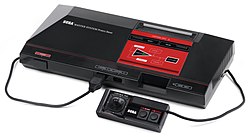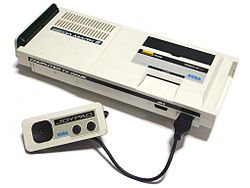
Back Master System AN سيجا ماستر سيستم Arabic سيجا ماستر سيستم ARZ Master System AST Sega Master System Bulgarian Sega Master System BR Sega Master System Catalan Sega Master System Czech Sega Master System Danish Sega Master System German
 | |
Top: North American/European Master System Middle: Japanese Sega Mark III Bottom: PAL Master System II | |
| Manufacturer | Sega |
|---|---|
| Type | Home video game console |
| Generation | Third generation |
| Release date | |
| Lifespan |
|
| Introductory price | JP¥16,800 US$200 GB£99 |
| Discontinued | |
| Units sold | Worldwide: 13 million (as of 2009) (not including recent Brazil figures)[5] Japan: 1 million (as of 1986)[6] United States: 2 million (as of 1993)[7] Europe: 6.8 million (estimated as of December 1993)[8] Brazil: 8 million (as of 2016)[9] |
| Media | ROM cartridge, Sega Card |
| CPU | Zilog Z80A @ 4 MHz |
| Memory | 8 kB RAM, 16 kB VRAM |
| Display | 256 × 192 resolution, 32 colors on-screen |
| Graphics | Yamaha YM2602B VDP |
| Sound | Yamaha VDP PSG(SN76489), Yamaha YM2413[a] |
| Backward compatibility | SG-1000[b] |
| Predecessor | SG-1000[c] |
| Successor | Sega Genesis |
| Related articles | Game Gear |
The Sega Master System (SMS)[d] is a home video game console made in 1985. It was not very popular in North America and Japan but was very popular in Brazil. One of the most popular games of the Master System was Sonic the Hedgehog.
As of 2015[update], the Master System was still in production in Brazil by Tectoy. This would make it the world's longest-lived console.[10]
- ↑ Cite error: The named reference
CEwas used but no text was provided for refs named (see the help page). - ↑ Cite error: The named reference
MK3was used but no text was provided for refs named (see the help page). - ↑ 3.0 3.1 Gamers High! Futabasha Super Mook (in Japanese). Futabasha. 2015. p. 55. ISBN 978-4-575-45554-0.
- ↑ Cite error: The named reference
MSwas used but no text was provided for refs named (see the help page). - ↑ Cite error: The named reference
GENSNESwas used but no text was provided for refs named (see the help page). - ↑ Cite error: The named reference
business_japanwas used but no text was provided for refs named (see the help page). - ↑ Cite error: The named reference
sheff_1993was used but no text was provided for refs named (see the help page). - ↑ Cite error: The named reference
digest_60was used but no text was provided for refs named (see the help page). - ↑ Cite error: The named reference
MDBwas used but no text was provided for refs named (see the help page). - ↑ Fick, Matthew (January 17, 2014). "Longest-lived game consoles". IGN Africa. Ziff Davis. Archived from the original on November 6, 2015. Retrieved September 21, 2015.
<ref group=lower-alpha> tags or {{efn}} templates on this page, but the references will not show without a {{reflist|group=lower-alpha}} template or {{notelist}} template (see the help page).


